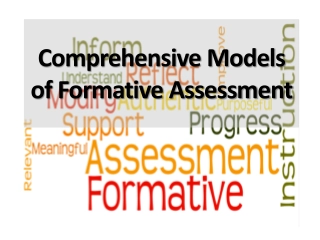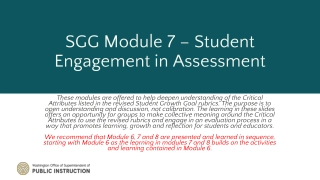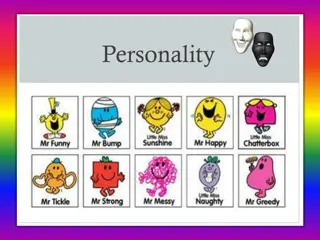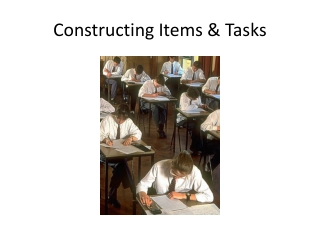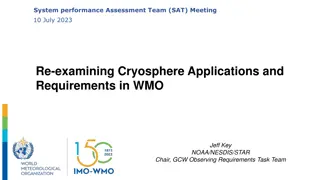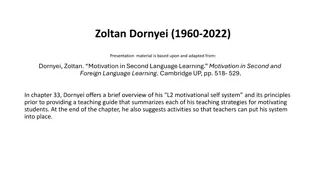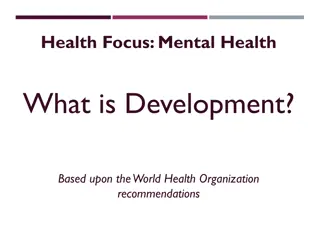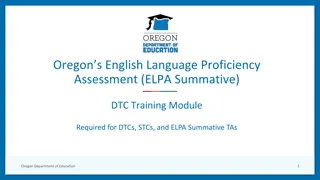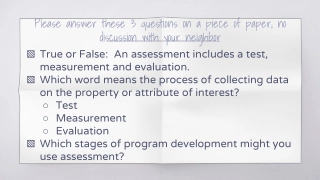Understanding the Cognitive Assessment System (CAS2) Theory and Applications
The Cognitive Assessment System (CAS2), developed by Dr. Jane Yeomans, is a comprehensive tool for assessing cognitive processes in children aged 5 to 18. Unlike traditional IQ tests, CAS2 focuses on areas like Planning, Attention, Simultaneous, and Successive processing. It requires Level 2 qualification for users and provides detailed assessments with supplemental scale scores. With a unique theoretical framework based on the PASS theory, CAS2 offers insights into cognitive abilities that are crucial for academic success.
Download Presentation
Please find below an Image/Link to download the presentation.
The content on the website is provided AS IS for your information and personal use only. It may not be sold, licensed, or shared on other websites without obtaining consent from the author. Download presentation by click this link. If you encounter any issues during the download, it is possible that the publisher has removed the file from their server.
Presentation Transcript
The Cognitive Assessment System (CAS2) Dr Jane Yeomans STEC Committee member SASC conference 2024
CAS basic information Age range 5 to 18 years Published by Pro-Ed and distributed in the UK by Hogrefe Current cost for full kit is 1230.00 excluding VAT Scoring: hand scoring, but it is possible to purchase access to online scoring direct from Pro-Ed Standardised 2008-2011. American standardisation Administration time: 1 to 1.5 hours, depending on which battery is used Core scales assess four areas of cognitive processing Supplemental scale scores can be obtained for Executive Function, Working Memory, verbal content and non verbal content Scores: Scaled scores for subtests Standard scores for composite areas with 90% or 95% confidence levels Percentiles
Who can use the CAS? Qualification level 2, which the publisher describes as follows: In order to be qualified at level 2 you must have: certified training and experience in a relevant discipline (e.g. clinical psychology, counselling psychology or speech and language therapy); membership of a professional organisation appropriate to the focus of the test; and/or evidence of competence in the use of psychological tests.
Whats in the bag? Interpretative and Technical Manual Administration and Scoring Manual 3 Stimulus Books Child Response Booklets (for ages 5-7 and another for ages 8-18) Figure Memory Response Booklet Scoring Template book (for Planned Codes, Planned Number Matching, Number Detection and Receptive Attention) Examiner Record Form Speed/Fluency Index Supplement
Underpinning theory of the CAS Uses a very different theoretical foundation from that of traditional IQ tests The basic theory is called PASS and is based on the work of Alexander Luria, a Soviet era neuropsychologist PASS: Planning, Attention, Simultaneous, Successive The CAS assesses cognitive processes rather than intelligence/IQ In contrast to the concept of IQ, cognitive processes are viewed as being open to change The four PASS areas assessed have direct links and relevance to academic attainment
Planning Processing Defined as: a child s ability to create a plan of action, apply the plan, verify than an action taken conforms to the original goal, and modify the plan as needed .. a neurocognitive ability used to determine, apply, self monitor, self correct, and control thoughts and actions so that efficient solutions to problems can be attained. Assessed as follows: Extended scale: Planned Codes, Planned Connections, Planned Number Matching Core scale: Planned Codes, Planned Connections Examples relevant to what is assessed for SpLD: Making a plan for written expression Taking a step by step approach to a maths word problem Selecting and using a strategy for reading comprehension
Attention Processing Defined as: a child s ability to focus cognitively while detecting particular stimuli and inhibit response to irrelevant competing stimuli . a neurocognitive ability used to selectively focus on a particular stimulus while inhibiting responses to competing stimuli presented over time. Assessed as follows: Extended scale: Expressive Attention, Number Detection, Receptive Attention Core scale: Expressive Attention, Number Detection Examples relevant to what is assessed for SpLD: Attending to a literacy or numeracy task long enough to see through to completion Filtering out redundant information in a text during reading comprehension activities Filtering out redundant information in a maths word problem
Simultaneous Processing Defined as: a child s ability to recognise how separate elements fit within an interrelated group ; a neurocognitive ability used to integrate separate stimuli into a single whole of interrelated group. Assessed as follows: Extended scale: Matrices, Verbal-Spatial Relations, Figure Memory Core scale: Matrices, Verbal-Spatial Relations Examples relevant to what is assessed for SpLD: Summarising the main idea of a prose passage Understanding how maths concepts relate (for example, the relationship between multiplication and addition)
Successive Processing Defined as: a child s ability to: recall or comprehend a series organisation or events ; a neurocognitive ability used to work with information that is arranged in a specific serial order in which each part follows the other in a strictly defined order, Assessed as follows: Sentence Questions (ages 8 to 18), Visual Digit Span Extended scale: Word Series, Sentence Repetition (ages 5 to 7), Questions (ages 8 to 18) Core scale: Word Series, Sentence Repetition (ages 5 to 7), Sentence Examples relevant to what is assessed for SpLD: Letter order for spelling Word order for written expression Solving equations in maths
Structure of the CAS: core scales The four core PASS areas are assessed as follows: Core Scale: 2 subtests per PASS area Planning: Planned Codes, Planned Connections Simultaneous: Matrices, Verbal-Spatial Relations Attention: Expressive Attention, Number Detection Successive: Word Series, Sentence Repetition (ages 5 to 7 or Sentence Questions (age 8 to 18) Extended scale: 3 subtests per PASS area Planning: Planned Codes, Planned Connections, Planned Number matching Simultaneous: Matrices, Verbal-Spatial Relations, Figure Memory Attention: Expressive Attention, Number Detection, Receptive Attention Successive: Word Series, Sentence Repetition (ages 5 to 7 or Sentence Questions (age 8 to 18), visual Digit Span Core or extended?
Structure of the CAS: supplemental scales Scores from the subtests are used to calculate supplemental Index Scores for the following: Executive Function with Working Memory Executive Function without Working Memory Working Memory Verbal content Non verbal content Speed and Fluency A comparison of performance when information is presented via auditory or visual modality
Scoring the CAS: Index scores For each PASS area standard Index scores are calculated from either two or three subtests Two subtests are used for core scale index scores, three subtests are used for extended scale index scores The descriptor index score is another term for a composite score Full scale score calculated using subtest scores from the four PASS areas Supplemental Scales also use standard scores Confidence levels can be calculated for either 90% or 95% confidence
Score category descriptors The publisher provides descriptive terms for index scores, as follows: Below 70: very poor 70-79: poor 80-89: below average 90-109: average 110-119: above average 120-129: superior Above 130: very superior
Scoring the CAS: verbal and non verbal supplemental scale scores, auditory/visual comparison Supplemental scale Description Subtests used Verbal content Measures the ability to solve problems that require recall and/or comprehension of verbal concepts or words. Verbal Spatial Relations Receptive Attention Sentence Questions Planned Codes Non content verbal Measures the ability to problem solve with images Matrices Figure Memory Auditory and visual comparison A examinee is presented with visual and auditory information comparison of performance when Word Series Visual Digit Span
Scoring the CAS: other supplemental scale scores Supplemental scale Working memory Tasks involving evaluating and working with information that had to be remembered for a short period of time. Description Subtests used Verbal Spatial Relations Sentence Questions Executive function without working memory Tasks that require control of thinking, behaviour, and attention. Planned Connections Expressive Attention Executive function working memory Tasks that require control of thinking, behaviour, and attention when working with information that has to be evaluated and remembered for a short period of time. Planned Connections with Verbal Spatial Relations Expressive Attention Sentence Questions Scores from the first two trials of the Expressive Attention subtest are used to calculate this index score Speed and fluency A general measure of processing speed. The pupil has to respond to very familiar stimuli (colour words and colours) as quickly as possible
Reliability and validity Meets STEC standardisation criteria Reliability data for subtests and index scores meet STEC criteria Validity: Content validity: comprehensive descriptions for each subtest. Test bias addressed explicitly; the authors assert that: these subtests on the CAS2 are free from gender, race and ethnic bias. Construct validity: meets STEC criteria for correlation with 7 other tests (for example, WJ-III, WRAT)
Where does the CAS fit into a diagnostic assessment? The principal use of the CAS is to contribute to the cognitive profile The advantage of using the CAS is that there are very clear links between assessment and intervention Therefore, it is possible to make recommendations that address the learner s cognitive processing, if there are areas of weakness
CAS and the cognitive profile element of a diagnostic report [1] Aspect of the report format Matching Aspect of the CAS Verbal Ability The CAS gives a supplemental score for verbal content However, due to its different model of intelligence does not set out to measure vocabulary knowledge or 'ability' traditional IQ or ability tests Measures of verbal ability may include vocabulary knowledge, verbal reasoning ability and general knowledge. as conceptualised by Visual/Non-Verbal Ability The CAS gives a supplemental score for non verbal content. However, due to its different model of intelligence does not set out to measure 'ability' as conceptualised by traditional IQ or ability tests Measures of non-verbal ability may include visual- spatial perception, pattern recognition, abstract reasoning skill, logic, problem solving and deduction.
CAS and the cognitive profile element of a diagnostic report [2] Aspect of the report format Matching Aspect of the CAS Supplemental score for WM, obtained from Verbal Spatial Relations and Sentence Questions subtests. The subtests do not include any assessment of phonological knowledge or skills Working Memory Measures of the ability to maintain and manipulate information in active attention. This would include phonological memory (ability to identify accurately, retain briefly, and repeat sequences of sound). Phonological Awareness The CAS does not assess this area Processing Speed Measures of processing speed (ability to perform relatively simple repetitive cognitive tasks, quickly, accurately and fluently). This would include rapid symbolic naming (ability to retrieve accurately well-known phonological responses fluently from long-term memory in response to a visual stimulus). Speed and fluency index, obtained from the first two trial scores of Expressive Attention subtest
From assessment to intervention The CAS model of intelligence emphasises that cognitive processes can be taught and thus improved Recommendations can be given for ways to improve processes The accompanying publication contains a wealth of resources for supporting cognitive improvement The materials include curriculum specific materials for reading, writing, spelling and maths
CAS and feedback The CAS explicitly suggests that feedback is given to examinees The HCL booklet seen in the previous slide contains handouts written for examinees The handouts use the phrase think smart Here are some examples from letters I send to pupils after an assessment I found out that you are good at seeing order and patterns. You were able to remember words in the right order. This thinking skill is important because it will help you with things like spelling and writing. When we spell words we have to write the letters in the right order in the word. When we are writing we have to think about the order of the words in a sentence and the order of events in a story. This thinking skill will also help you with maths, because a lot of maths work is about sequences and patterns This picture shows how numbers can be arranged in patterns, so we can just look at the dots and know that the pattern tells us how many.
More feedback examples I found out that there aren t any problems with your thinking skills. This is great news because we need thinking skills for every subject in school. Thinking skills help you to work out problems. What s important about thinking skills is to use them to help you with your school work. These are the thinking skills that are working well with some ideas for using them when you re reading and spelling. Planning This is about setting goals and making plans. For example, making a plan for writing a story. This is about patterns and sequences. For example, using Successive: letter patterns for spelling words. Seeing the big picture and how things fit together, For example, when you have read a story, saying the main idea of Simultaneous: the story. Being able to focus your thinking on something and resist Attention: distractions
Strengths Highly relevant to an assessment for specific learning difficulties because it aims to examine how well that child will cope with learning tasks and what obstacles to efficient learning the child may be experiencing The tasks are suitably challenging for the age range without being intimidating or undermining. Although the battery is American, the amount of cultural influence is minimised. The tests require very little acquired knowledge, and the language used throughout is simple. There are strong similarities to tests which other batteries may refer to as verbal working memory, visual memory, processing speed, non-verbal ability, listening comprehension
More strengths Instructions are easy to follow and unambiguous, and administration and scoring are straightforward Stimuli books are large and well presented. Considerable assistance is given with identifying variations within the profile and evaluating whether those variations are clinically significant.
Issues for examiners to consider CAS2 takes a very different approach to traditional IQ and attainment testing. Although many of the subtests are similar, the way they are defined and interpreted is different. Consequently, the composites and subtests do not automatically fit under the subheadings within SASC s Report Format. Professionals transferring to using CAS2 will need training in its approach For the purposes of a diagnostic assessment of SpLD CAS2 would need to be supplemented with tests of phonological awareness and receptive vocabulary, as well as the normal range of attainment tests. The battery is only standardised up to 18 years 11 months. It is not, therefore, suitable for use with adults.
Finally Questions? Comments? Feedback? The Hogrefe panel of experts will participate in the Q and A session
















